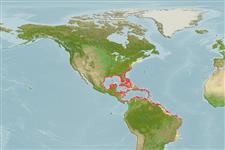Actinopterigi (pesci con pinne raggiate) >
Perciformes (Perch-likes) >
Carangidae (Jacks and pompanos) > Trachinotinae
Etymology: Trachinotus: Greek, trachys, -eia, -ys = rough + Greek,noton = back (Ref. 45335).
Ambiente / Clima / Range
Ecologia
; marino; salmastro associati a barriera corallina; distribuzione batimetrica 0 - 36 m (Ref. 3277), usually 0 - 30 m (Ref. 55175). Subtropical, preferred ?; 42°N - 25°S, 100°W - 30°W (Ref. 55175)
Western Atlantic: Massachusetts, USA to southeastern Brazil, including Bahamas and many of the West Indies.
Length at first maturity / Size / Peso / Age
Maturity: Lm 54.7, range 48 - ? cm
Max length : 122 cm FL maschio/sesso non determinato; (Ref. 40637); common length : 94.0 cm FL maschio/sesso non determinato; (Ref. 3277); Peso massimo pubblicato: 36.0 kg (Ref. 5217); Età massima riportata: 23 anni (Ref. 42149)
Spine dorsali (totale): 6 - 7; Raggi dorsali molli (totale): 18-21; Spine anali 2-3; Raggi anali molli: 16 - 18. Dorsal and anal fins have very long, dark anterior lobes (Ref. 26938). No scutes; a broad patch of orange-yellow on abdomen in front of anal fin; pectoral fins blackish (Ref. 13442).
Adults frequently in channels or holes, over sandy flats, around reefs, and at times over mud bottoms; usually solitary or in small schools; smaller fish tolerate brackish water. Spawn offshore (Ref. 26938). During the summer, juveniles are found in large schools especially in the surf zone along sandy beaches. Adults feed on mollusks, crabs, shrimps, and small fishes; juveniles on benthic invertebrates. Excellent food fish (Ref. 9626). Highly esteemed game fish caught on light tackle (Ref. 26938).
Life cycle and mating behavior
Maturità | Riproduzione | Deposizione | Uova | Fecundity | Larve
Robins, C.R. and G.C. Ray, 1986. A field guide to Atlantic coast fishes of North America. Houghton Mifflin Company, Boston, U.S.A. 354 p. (Ref. 7251)
IUCN Red List Status (Ref. 115185)
CITES (Ref. 94142)
Not Evaluated
Threat to humans
Harmless
Human uses
Pesca: commerciale; Acquacoltura: commerciale; Pesce da pesca sportiva: si; Acquario: Acquari pubblici
Strumenti
Special reports
Download XML
Fonti Internet
